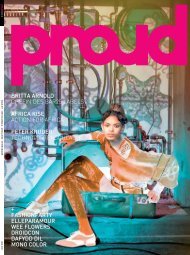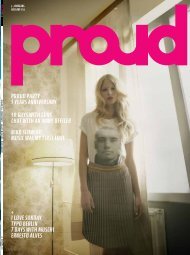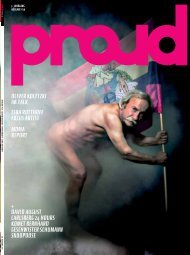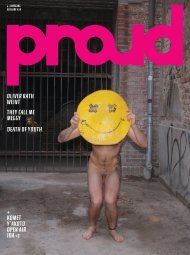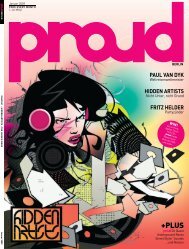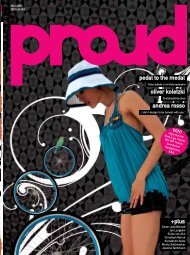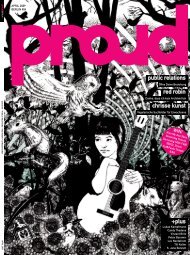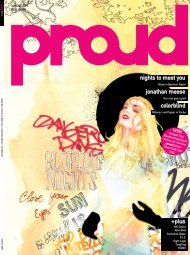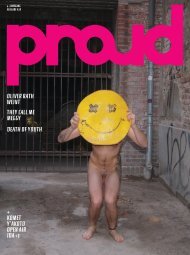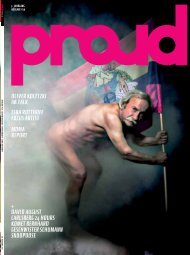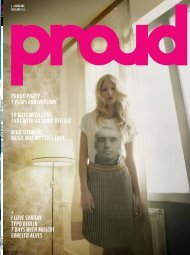PROUD PHOTO BOOTH BY OLIVER RATH ... - Proud magazine
PROUD PHOTO BOOTH BY OLIVER RATH ... - Proud magazine
PROUD PHOTO BOOTH BY OLIVER RATH ... - Proud magazine
Sie wollen auch ein ePaper? Erhöhen Sie die Reichweite Ihrer Titel.
YUMPU macht aus Druck-PDFs automatisch weboptimierte ePaper, die Google liebt.
48<br />
CHAT<br />
BLUES ON CANVAS<br />
Interview mit Nicholas Kashian<br />
N<br />
icholas Kashian ist Amerikaner,<br />
geboren und aufgewachsen<br />
in Bloomington, Illinois. Er lebt<br />
seit drei Jahren in Berlin. Er hatte nicht<br />
geplant zu bleiben. Über sein Leben als<br />
Künstler, seine Entwürfe und Impulse,<br />
die Frage, ob man NICHTS malen<br />
kann, und seine aktuelle Arbeit „Desperate<br />
Man Blues“ sprechen wir. Auf<br />
einem Perserteppich. Zu kubanischer<br />
Musik und Wasser aus Weingläsern.<br />
Um punkt 18 Uhr klopfe ich an die<br />
schwere Stahltür im dritten Stock<br />
der Fabriketage in Schöneberg. Als<br />
keiner aufmacht, drücke ich mich mit<br />
aller Kraft dagegen und gleite in eine<br />
Welt aus Farben, Leinwänden und<br />
abgebröckeltem Putz. Der angenehm<br />
stechende Geruch von Ölfarbe kommt<br />
mir entgegen. „Smells nice“, sage ich,<br />
trotz der Kürze, holprig. Nicholas nickt<br />
und ich denke, er freut sich darüber.<br />
Er ist entspannt. Wir setzen uns. Er<br />
kippt gelblich leuchtendes Wasser in<br />
ein staubiges Weinglas. Das macht<br />
ihn sympathisch. Sein Schreibtisch ist<br />
ein Sammelsurium loser Zettel, Notes<br />
sagt er, aufgeschlagener Fotobänder,<br />
Skizzen, Stifte und Pinsel. Ich schalte<br />
mein Diktiergerät ein. Nicholas dreht<br />
sich eine Zigarette und ascht auf den<br />
Teppich unter uns. Im Hintergrund<br />
läuft Musik. Zu „Chan Chan“ von Buena<br />
Vista Social Club steht er auf mit<br />
den Worten „I can’t stand this song.<br />
It’s really beautiful, but I’ve heard it<br />
like 500 times.“ Was er noch schön findet,<br />
frage ich ihn jetzt - und er beginnt<br />
zu zeichnen..<br />
You have been noted for your “dialogue<br />
between commercial mythology<br />
and the complexity of the real life”.<br />
What does that mean?<br />
The apparatus that artists are supposed<br />
to work within, this business part<br />
of the job, is a very difficult one. Kind of<br />
a dirty one. Kind of a confusing one, to<br />
me. I try to avoid it as much as possible.<br />
I am working with all of what looks like<br />
an artist, but I don’t really function as<br />
one, in the ‘commercial myth’ sort of<br />
way. I have a show here and there, but<br />
to be a really successful artist, you have<br />
to play all these games that I haven’t<br />
figured out how to play yet. You know, I<br />
work as a cook to be able to paint and<br />
live. I take care of my son every day.<br />
This is the complexity of life, which is,<br />
you know, real life.<br />
You once said: “I view art making as a<br />
payment, constant and joyfully given<br />
for the gift and paradox of life.” Who<br />
is being paid here?<br />
I have a problem saying that that painting<br />
is worth like 2000 Euros. Obviously<br />
we live in a certain social structure<br />
where value is given to things, most often<br />
with money. That comment fights<br />
that structure. In the work that I am<br />
doing, I try not to think about value in<br />
terms of money but in terms of objects<br />
and effort. But the ‘payment’ is not really<br />
to ‘anyone’ in particular, but more<br />
a reaction to a sense of obligation that<br />
I feel for ‘the gift and paradox of life’.<br />
An offering somehow. And anyone that<br />
sees the work can get something from<br />
it, if they want. I think, once in a while,<br />
when the work is really beautiful, really<br />
strong, then it’s a gift. And, it’s not<br />
really given by me, but only that I am<br />
in the place to put it there. As an artist<br />
you are given so much with your work<br />
if you are really into it. You should feel<br />
inclined to give it back.<br />
What kept you in Berlin?<br />
I took this studio the first week that I<br />
was here. I was meeting a lot of people…a<br />
lot of artists, and that had the<br />
effect to say that this is a place where<br />
I can still learn things. That is what<br />
kept me here initially. And then there<br />
is the history, and the art that is here.<br />
The museums are great and I love the<br />
changes between neighborhoods. To<br />
discover the work that lives here in Berlin<br />
is really exciting. Down the street is<br />
the Neue Nationalgalerie and Gemäldegalerie.<br />
That’s a really nice privilege<br />
to have such great, important works<br />
around you.<br />
Tell me more about your relationship<br />
with museums…<br />
My father is also an artist- he started<br />
out as a painter and performance artist<br />
and is now a photographer. So my<br />
sister and I were around artists all the<br />
time. My father wanted to see art, so<br />
we would go to museums a lot. Also my<br />
son has been to some of the best museums<br />
in the world. He is not even two.<br />
For me museums are education. It’s as<br />
important as going to school or going<br />
to church or to any other place to learn<br />
about culture and history. Depending<br />
on the quality of the collection of the<br />
museum. Another thing about art is<br />
that it’s a series of very tangible documents<br />
in history. Art has always been<br />
there. And the real challenges that artists<br />
face now are not any different that<br />
throughout history. If you are a sculptor,<br />
for instance, you have only the<br />
choice to add material or to subtract<br />
it. You can learn a lot from museums.<br />
I think a lot of my knowledge is from<br />
looking at art in museums and reading<br />
about why the work was made. Also to<br />
learn the craft, to learn the techniques,<br />
to learn the relationships between different<br />
works or the work itself within<br />
itself and the development of art- a<br />
museum is currently the best place to<br />
find all that. To see the actual work. We<br />
can look at a ton of images within a few<br />
seconds in reproduction if we want.<br />
But, singular works were made very<br />
specifically. Which is why I hate having<br />
a website- it diminishes the paintings,<br />
so instantly the second you photograph<br />
them. I think everything is diminished,<br />
when it changes form. Maybe not diminished,<br />
it’s just changing. I don’t<br />
know how…. if it get’s better or worse.<br />
When is a piece of art beautiful?<br />
A piece of art is beautiful when it stops<br />
your breath. There’s nothing formulaic<br />
about it. Something like beauty is inde-<br />
CHAT<br />
49



